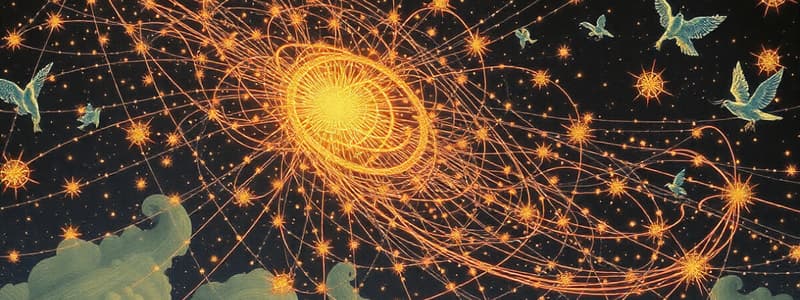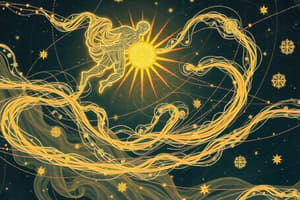Podcast
Questions and Answers
What represents the interaction between two objects in Newton's third law of motion?
What represents the interaction between two objects in Newton's third law of motion?
- Two forces having equal magnitudes and opposite directions (correct)
- The average speed of both objects
- The total mass of both objects
- The sum of their velocities
In the notation of Newton's third law, what does FAB represent?
In the notation of Newton's third law, what does FAB represent?
- The combined force of both objects
- The force exerted by object A on object B (correct)
- The net force acting on object A
- The force exerted by object B on object A
Which of the following describes the correct method for modeling forces on an object?
Which of the following describes the correct method for modeling forces on an object?
- Model only the forces acting on the specific object of interest (correct)
- Include forces even if they don't affect the motion of the chosen object
- Use arbitrary values for forces to simplify calculations
- Consider the forces each object exerts on all other objects in the system
What is a free-body diagram primarily used for?
What is a free-body diagram primarily used for?
Which term describes the study of forces on objects at rest?
Which term describes the study of forces on objects at rest?
What defines a system in the context of studying forces?
What defines a system in the context of studying forces?
What is true about a dynamic system?
What is true about a dynamic system?
What is the general equation that is widely applicable in physics related to motion?
What is the general equation that is widely applicable in physics related to motion?
What does the length of an arrow in a vector diagram represent?
What does the length of an arrow in a vector diagram represent?
Which concept involves writing specific equations for different scenarios in physics?
Which concept involves writing specific equations for different scenarios in physics?
What does Newton’s first law of motion state about an object's motion?
What does Newton’s first law of motion state about an object's motion?
How is inertia related to mass?
How is inertia related to mass?
What is the SI unit of force?
What is the SI unit of force?
What is the vector sum of all the forces acting on an object referred to as?
What is the vector sum of all the forces acting on an object referred to as?
What does momentum represent in terms of an object's motion?
What does momentum represent in terms of an object's motion?
Why is it more difficult to stop a fast-moving object compared to a slow-moving one?
Why is it more difficult to stop a fast-moving object compared to a slow-moving one?
How is Newton's second law of motion mathematically expressed?
How is Newton's second law of motion mathematically expressed?
What is true about the mass of an object in different locations, such as Earth and the Moon?
What is true about the mass of an object in different locations, such as Earth and the Moon?
What is the primary cause of a change in motion or shape of an object?
What is the primary cause of a change in motion or shape of an object?
What does inertia measure in an object?
What does inertia measure in an object?
Why is it easier to push a lawnmower than a car?
Why is it easier to push a lawnmower than a car?
How is force related to motion according to Newton's second law?
How is force related to motion according to Newton's second law?
What is the SI unit of momentum?
What is the SI unit of momentum?
Which statement best describes net force?
Which statement best describes net force?
What does mass symbolize in the context of inertia?
What does mass symbolize in the context of inertia?
In which situation would momentum be most useful for analysis?
In which situation would momentum be most useful for analysis?
Which of the following correctly identifies the relationship between force, mass, and acceleration?
Which of the following correctly identifies the relationship between force, mass, and acceleration?
Why does an object moving quickly have more momentum than one moving slowly?
Why does an object moving quickly have more momentum than one moving slowly?
What happens to an object's mass when it is moved from Earth to the Moon?
What happens to an object's mass when it is moved from Earth to the Moon?
Flashcards are hidden until you start studying
Study Notes
Newton's Laws of Motion
- Motion remains unchanged unless an external cause acts upon it, as stated in Newton's first law of motion.
- An object at rest remains at rest, and an object in uniform motion stays in motion in a straight line unless acted upon.
Inertia and Mass
- Inertia is the resistance to change in motion; mass quantifies inertia.
- The SI unit for mass is kilograms (kg); higher mass means greater inertia, making acceleration more challenging.
- Mass remains constant regardless of location (Earth, Moon, or space).
Forces and Acceleration
- A force is the cause of motion or shape change from interactions between objects.
- Force is measured in newtons (N) and is a vector quantity, indicating both magnitude and direction.
- The net force is the vector sum of all forces acting on an object, and it relates to changes in motion as described by Newton’s second law of motion.
Momentum
- Momentum is the product of an object’s mass and velocity, representing its total motion.
- An object with more momentum is harder to stop; changes in momentum can also be evaluated using Newton’s second law.
Interaction of Forces
- Newton’s third law of motion involves action-reaction pairs; forces have equal magnitudes and opposite directions.
- If object A applies a force on object B (FAB), object B simultaneously applies an equal and opposite force on object A (FBA).
- Third-law pairs illustrate interactions without affecting the analysis of individual objects involved.
Modeling Forces
- To analyze a single object's motion, consider only the forces acting on that object and ignore how it affects others.
- For example, examining how a rope’s motion changes when pulled requires evaluating only the forces exerted on the rope, not the forces the rope exerts back.
Systems and Free-Body Diagrams
- A system comprises objects under study, often interacting mechanically or through a common interaction.
- A free-body diagram graphically represents forces and resulting effects on an object or system, illustrating force magnitude and direction with arrows.
Statics and Dynamics
- Statics studies balanced forces on stationary objects, where net force and acceleration are zero.
- Dynamics examines forces on moving objects, which can be at constant velocity or accelerating, using Newton’s second law in force-acceleration equations.
Mathematical Models
- Different scenarios require tailored mathematical models; general equations apply broadly but may require deeper analysis.
- Specific equations are tailored for particular problems; Newton’s second law serves as a general framework that can be specified for individual cases using free-body diagrams.
Newton's Laws of Motion
- Objects remain at rest or in uniform motion unless acted upon by an external force, known as Newton's first law of motion.
- Acceleration causes a change in velocity; different objects respond differently to accelerating forces due to their inertia.
Inertia and Mass
- Inertia is the resistance of an object to changes in its motion; greater mass equates to greater inertia.
- Mass is measured in kilograms (kg) and is consistent regardless of location (e.g., Earth, moon, space).
- Example: Pushing a lawnmower requires less effort than pushing a car due to the car’s higher mass and inertia.
Forces and Net Force
- A force is defined as the cause of motion change or shape alteration due to unopposed interactions.
- Forces are measured in newtons (N) and are vector quantities, meaning they have both magnitude and direction.
- The net force is the vector sum of all forces acting on an object; it determines the object's acceleration, as described by Newton's second law of motion.
Momentum
- Momentum is the product of an object's mass and velocity, indicating its total quantity of motion.
- An object in motion has more momentum and is harder to stop than when it’s moving slowly.
- Newton's second law can also relate to momentum changes, making it relevant in scenarios involving velocity without acceleration or during collisions.
Newton's Third Law of Motion
- Forces arise from interactions between two objects, where each exerts equal but opposite forces on one another.
- If object A applies a force on object B, then B applies an equal and opposite force on A.
- This interaction is represented as action-reaction pairs (e.g., FAB and FBA).
- Each force in a third-law pair represents the interaction and its effect on each object involved.
Studying That Suits You
Use AI to generate personalized quizzes and flashcards to suit your learning preferences.




